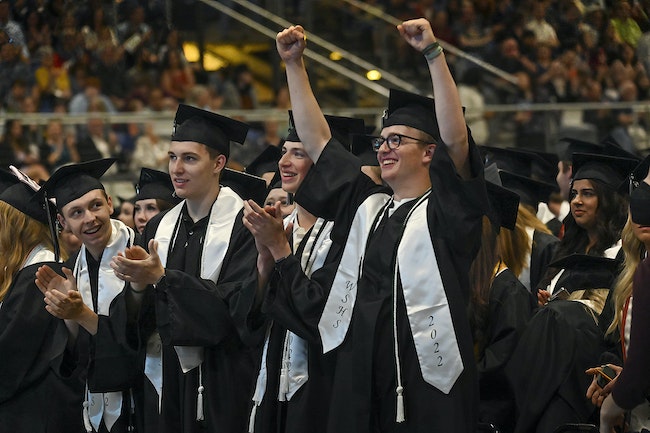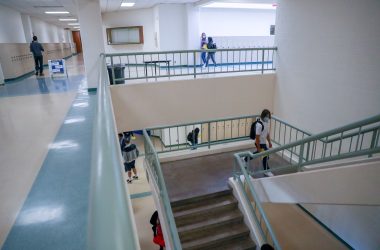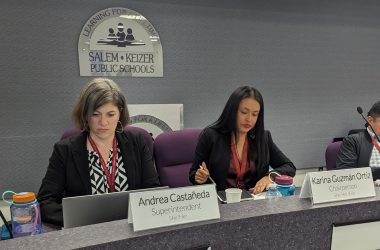Despite beginning high school during a global pandemic, Oregon’s class of 2023 maintained a relatively high on-time graduation rate, and some groups set new records.
More than 37,000 Oregon students graduated in 2023, 81.3% of the class, according to Oregon Department of Education data published Thursday. That rate tied that of the class of 2022 but marked a slight decline from the pre-pandemic class of 2019. In that class, 85% graduated on time, marking a high for Oregon.
State and agency officials expressed cautious optimism about the ability of schools and students to make up for lost time while taking virtual classes during the pandemic. Among some groups of students, including English-language learners, Native Hawaiians, Pacific Islander, and special education students, graduation rates rose from previous years.
But chronic absenteeism remains a challenge among high school seniors. Data from the department shows that last year more than half of Oregon seniors missed more than three weeks of school.
“COVID really changed our relationship with attendance,” Oregon’s education director, Charlene Williams, said during a media call Tuesday. “We really have to recover from the effects of the pandemic and get people back in school, on time, all day, every day so that our students can maximize learning.”
Williams pointed to a number of state investments that have helped maintain graduation rates, including the Student Investment Account, which allocated $890 million to Oregon schools between 2021 and 2023. Schools must use the money on programs, staff and curricula that can close achievement gaps. Williams also pointed to Measure 98, passed in 2016, which funds ninth-grade coaches and career technical education programs. Among the Oregon high schoolers in the class of 2023 who completed at least two career and technical education credits, 95% graduated on time.
“It’s important that we are seeing some positive results in key areas where the state has been targeting resources,” Gov. Tina Kotek said in a news release. “So, let’s do more of that, and I hope lawmakers support summer learning investment in the 2024 session.”
Lawmakers will consider a $50 million summer school package during the upcoming short session that begins Feb. 5. Last year, the Legislature did not allocate any additional funding, leaving schools and community groups scrambling to offer scaled back options for students and families. Some even cut summer programming all together. During and immediately following pandemic school closures, districts and community groups had record funding for summer school.
Bright spots, sticking points
English language learners, or students who became proficient in English through a program prior to entering high school, had a graduation rate of nearly 88%, an all-time high for this group. In the Salem-Keizer School District, the graduation rate among English learners grew nearly four percentage points from the previous year, and up 28 percentage points from the class of 2018. Five of the district’s six comprehensive high schools had graduation rates that exceeded the statewide average.
“Despite our slight overall drop, we have areas of growth and promise that are worthy of celebration,” Deputy Superintendent Iton Udosenata said in a news release.
Statewide, students in special education who are on individualized education plans graduated at nearly 69%, also a high for these students. Native Hawaiian and Pacific Islander students saw average graduation rates rise slightly, while average graduation rates for nearly all other students stayed the same or declined slightly.
The percentage of 10th graders currently in Oregon high schools who are on track to graduate in the next three years is nearing pre-pandemic levels, according to recent state data. Statewide, about 84% of the class of 2026 is headed towards graduation.
After high school, however, a growing number of students are choosing not to go on to higher education. About 56% of Oregon’s class of 2021 enrolled in college within 16 months of graduating, the most recent data. That’s down from 63% before the pandemic and follows a national trend. Nationwide, about 62% of 2021 high school graduates enrolled in college, according to the National Center for Education Statistics. During the last decade, undergraduate enrollment in colleges nationwide has declined 15%.
Oregon Capital Chronicle is part of States Newsroom, a network of news bureaus supported by grants and a coalition of donors as a 501c(3) public charity. Oregon Capital Chronicle maintains editorial independence. Contact Editor Lynne Terry for questions: [email protected]. Follow Oregon Capital Chronicle on Facebook and Twitter.
STORY TIP OR IDEA? Send an email to Salem Reporter’s news team: [email protected].

Alex Baumhardt has been a national radio producer focusing on education for American Public Media since 2017. She has reported from the Arctic to the Antarctic for national and international media, and from Minnesota and Oregon for The Washington Post. She previously worked in Iceland and Qatar and was a Fulbright scholar in Spain where she earned a master's degree in digital media. She's been a kayaking guide in Alaska, farmed on four continents and worked the night shift at several bakeries to support her reporting along the way.









